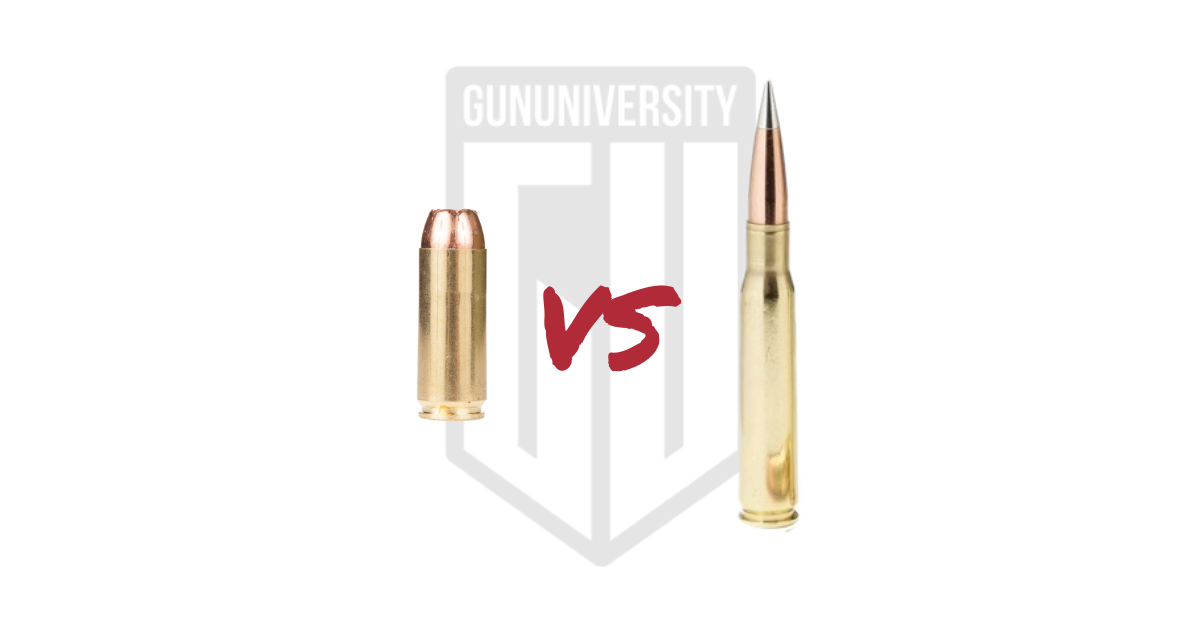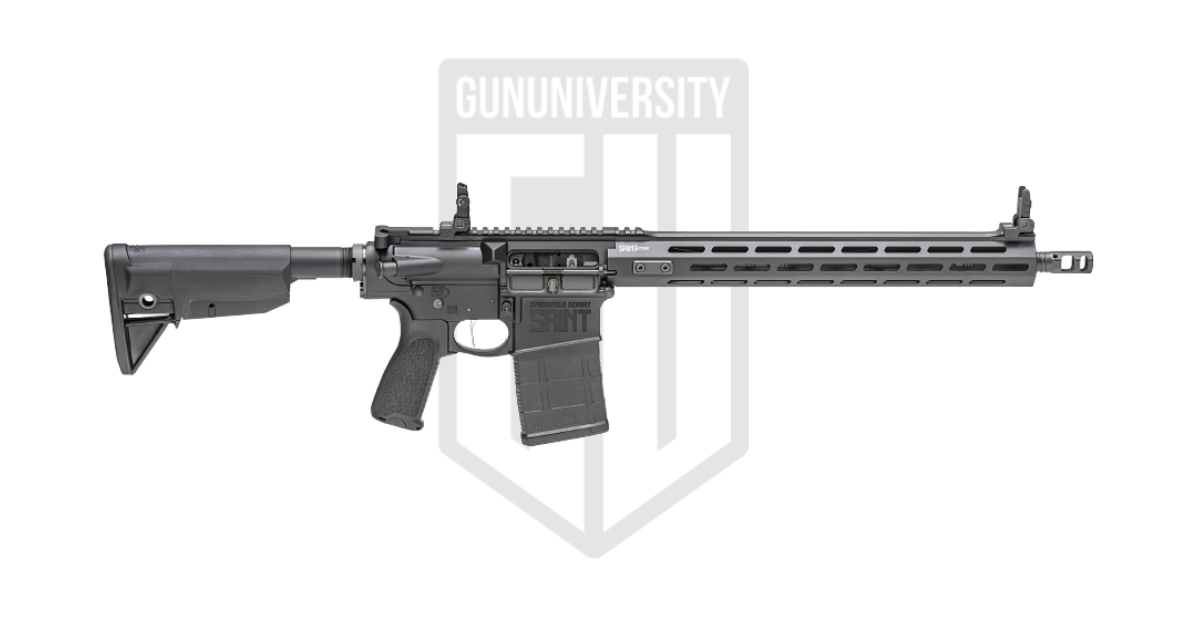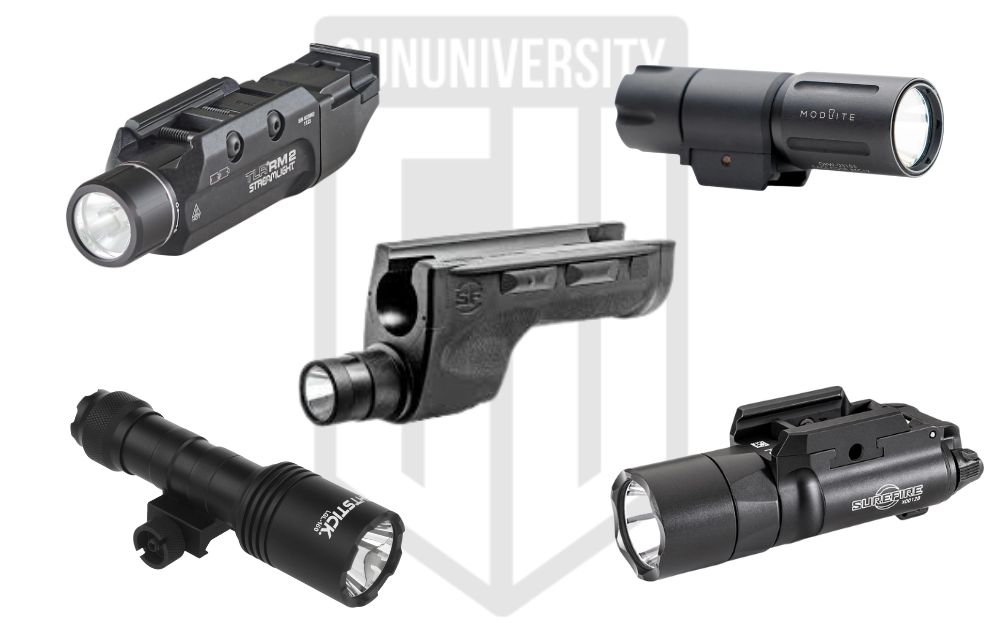What are Mils? Understanding and Using Milliradians
If you’re looking to understand what Milliradians (Mils) are and how they’re used in shooting a scoped rifle, you’re in luck!
If there’s one thing I’ve gained in my experience as a special operations sniper, sniper instructor, long range shooter, hunter, and as the best selling author of the Long Range Shooting Handbook, it’s how to break topics like this down in a simple way.
In this Milliradian guide, I’m going to teach you everything from the meaning of “Mil” to how to use Mils on your scope.
If you’re here to learn about Mils, there’s a good chance it’s because you’re interested in learning how to adjust your rifle scope or zero (sight in) your rifle. If so, you should also check out those articles next.
Also, if you’re curious about Minutes of Angle (MOA), which are very similar to Mils, you should check out our article on Understanding MOA.
Table of contents
What are Mils?
Mil is an abbreviation of “Milliradian.” It is an angular measurement that equates to 1/1000th of the distance it travels.
The prefix “Milli” comes from the metric system and it means 1/1000th. A radian is a trigonometry term for a certain angle of a circle based on the radius of that circle.
Milliradians Explained
There are two key parts to that term “Milliradian.” There is “Milli” and “radian.” Let’s start by digging deeper into radians.
A radian is determined by the resulting angle between both ends of a radius length section of the circumference of a circle. There are 2π radians in a circle. 2*3.14 = 6.28 radians in a circle.

Let’s use this diagram for some help.
If you take the radius, which is the measurement from the center of a circle to its edge (A in the diagram), and “wrap” that length around the outer edge of the circle (B), then the angle from the center of the circle to both ends of (B) is one radian (C).
Hopefully, you can see the rough estimation above gives you a good enough idea: it’s about 1/6th of the circle or about 57 degrees. :)
So, we now know what a radian is and we know that the prefix “milli” means 1/1000th. Therefore, we now know that 1 milliradian is an angle equal to 1/1000th of a radian.
What is key for us to understand, especially when using MILs for shooting, is that Milliradians are angular and not a linear measurement. This means that a Milliradian is just like any other angular measurement… it can only refer the the angle between two things and NOT a length. This will be important in to remember in the next section.
Using Milliradians in Shooting
You may now be asking: “Why are Mils used with rifle scopes and long range shooting?”
Great question! But first, let me give you an example that will help to demonstrate why shooters work with angles:
Imagine yourself standing at the center of the circle in the diagram above and you spread two laser pointers 1 Milliradian apart and shine them along the radius to the edge of the circle (“A” distance), then the dots will spread exactly 1/1000th of the length of the radius (“A” distance) apart.
Remember, that’s because (B) is the same length as (A) and we have chopped (B) into 1,000 title chunks to get one Mil. Therefore, 1 Mil is always 1/1,000th of whatever distance.
Therefore, 1 Milliradian equals 1/1000th of ANY distance.
One Mil is 1 inch at 1000 inches and it is also 1 mile at 1000 miles.
It doesn’t matter what unit of measurement you are using as long as you keep using that unit of measurement.
At 1000 meters 1 Mil is 1 meter tall. Therefore, at 1/10th the distance of only 100 meters, 1 Mil is 1/10th as tall: 10 cm (1/10th of a meter). This means that 1 Mil is exactly 10 centimeters (cm) at 100 meters (m), 20 cm at 200 m, 30 cm at 300 m, and so on.
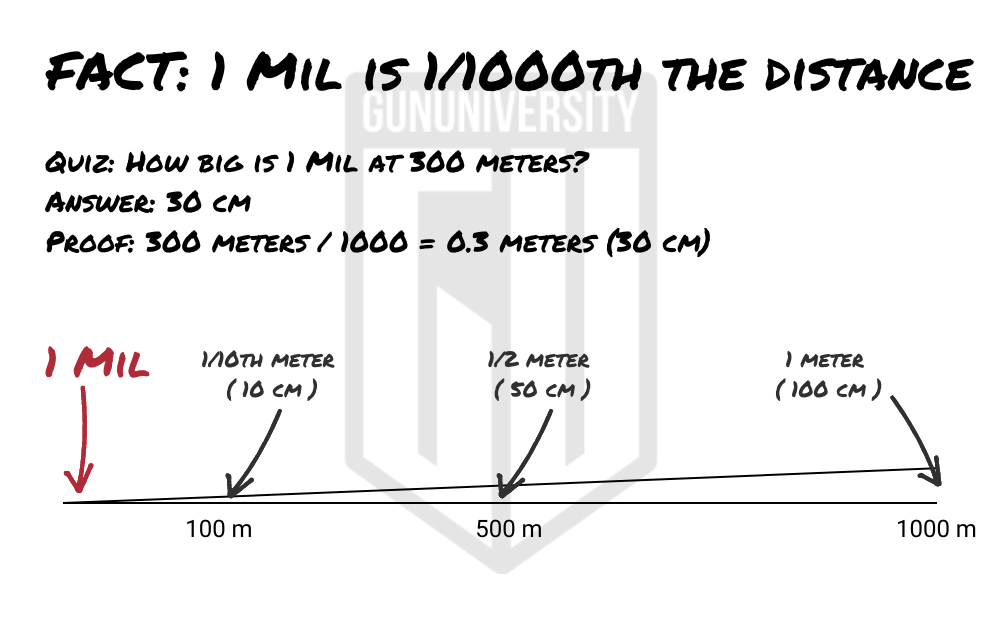
Let’s do the math to see if that check out: Because we are dealing with the metric system, we can simply move the decimal place from 100.0 meters to the left 3 places to find 1/1000th. Moving the decimal three positions to the left in 100.0 meters results in 0.1000 meters (1/10th of a meter). Because there are 100 cm in a meter, 1/10th of a meter is 10 cm.
Most scopes with Mil turrets adjust in 0.1 (1/10th) Mil increments (0.1 Mil per “click”). If 1 Mil is 10 cm at 100 meters, then 1/10th of a Mil is 1 cm at 100 meters. Therefore a single 0.1 Mil adjustment on a Mil scope will move the bullet impact 1 cm per 100 meters.
Understanding Mils Videos
Here are videos of me explaining what Mils are, how to use Mils in the field/at the range, and how to use Mils for range estimation:
How to Use Milliradians for Shooting
If you want to use your Milliradian scope effectively, I ask you to consider using my “trick.”
Once I know the distance at which I am shooting (or the distance at which the shooter is shooting if I’m spotting), I immediately determinate how big 1/10th of a Mil will be at that distance.
If I’m working with MOA, I use the same trick but I just imagine how big 1 MOA is at that distance.
For example, if I am shooting at 600 meters, I know that 1/10th of a Mil is 6 cm at that distance. Therefore, I start thinking in 6 cm “chunks.”
If the bullet impacts 12 cm low, I know that I need to adjust up 2/10ths of a Mil (0.2 Mil) because two 6 cm “chunks” fit within the 12 cm adjustment I need.
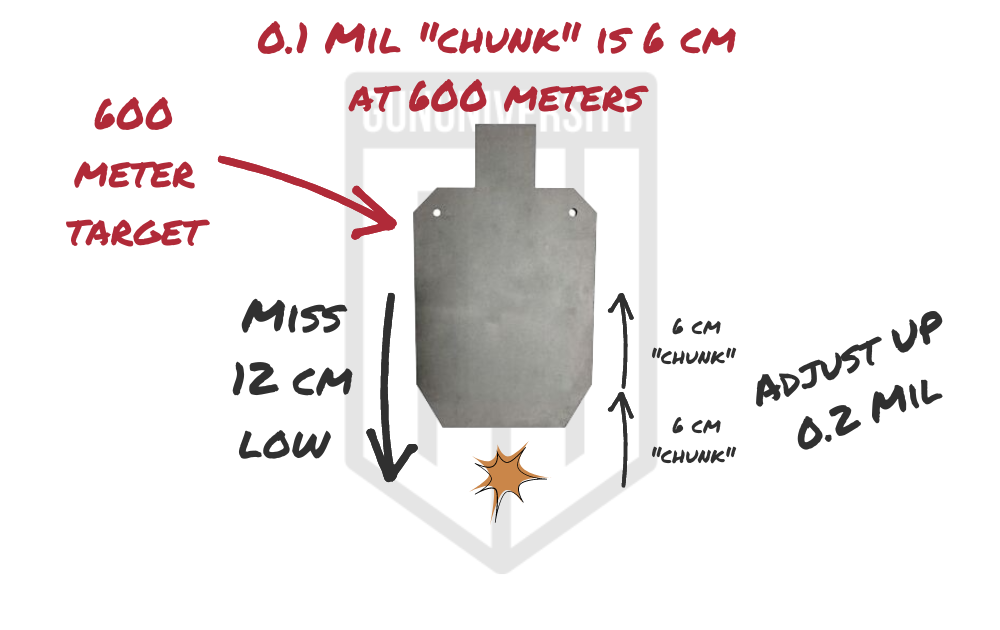
When you are zeroing your rifle, or otherwise shooting at 100 meters, you now know that 0.1 Mil is 1 cm at that distance. Therefore, whenever you need to make an adjustment, you should ask yourself how many 1 cm “chunks” are needed to adjust your bullet impact to where you want it to be. The resulting answer is how many 1/10ths of a milliradian you need to adjust on your Mil scope.

You might have noticed that I’m using centimeter adjustments and meters for target distance. You may need to convert your numbers.
If you know the target distance in yards and you need it in meters, just subtract 10% of the distance to convert yards to meters. e.g. I have a distance of 600 yards and I need it in meters. 10% of 600 is 60. If I subtract 60 from 600, I am left with 540. Therefore 600 yards = 540 meters.
Likewise, you might have inches and need centimeters. To convert inches to centimeters, you multiply the inches times 2.54 to get a result in centimeters.
Milliradian Reticle
The original Milliradian reticle was the “Mil Dot” Reticle. The Mil-Dot Reticle, which was what was in the scopes I was issued in the military as a sniper, is a reticle (cross-hairs) that has reference marks (dots) 1 Mil apart.

The original Mil-Dot was a football shaped dot, however, this was quickly replaced (everywhere except the Marine Corps) with a round dot.
The distance from a certain point on one dot to the same spot on an adjacent mild was 1 Mil. So, from the center of one dot to the next dot was one mil. Similarly, the distance from the edge of one dot to the same edge of the next dot is 1 Mil.
The round mil dots were 0.2 Mil in diameter – this means that the measurement between two dots is 0.8 Mil and from the outside edge of two adjacent dots is 1.2 Mil.
This breakdown of other measurements is important when range estimating with Mil Dots as a 0.1 Mil difference in your measurement can make a difference in distance large enough to cause you to miss your target.
However, modern milliradian reticles are typically a “Christmas tree” style wherein there are numerous hash-marks not only along the vertical and horizontal crosshairs for fractions of Mils, but also a graduated series of lines below the main aiming point that allow for “holding” for windage and elevation.

Mil vs MOA
So, which is better, Mils or MOA? That depends no a couple of things…
I mostly use MOA for my long range shooting but that’s because I have many MOA scopes and many tax payer dollars have been spent teaching me MOA.
However, Mil is a superior system and I would recommend most new shooters start with Mil with one caveat: if you have a group of shooting buddies that you’ll shoot long range with and they all shoot MOA, then you might want to start with MOA to be able to learn using a common language with them.
Check out MOA vs Mils for a more complete breakdown.
Mil Formulas and Calculations
Here are some formulas you can use when working with Mils while shooting:
Simple Mil Formulas:
Meters to Target / 100 = centimeters per 0.1 Mil adjustment at that distance
Centimeters of Adjustment Needed / Size of 0.1 Mil Chunk in centimeters = 0.1 Mil adjustment
Clicks per Mil on Scope x Number of Mil Adjustment Needed = Number of Clicks Needed for Adjustment
Mil Calculations:
Mils -> MOA: Mils * 3.438 = MOA
Mils -> centimeters per 100 meters: Mils x 10 = centimeters per 100 meters
Inches -> Centimeters: Inches * 2.54 = Centimeters
Yards -> Meters: Yards – 10% = Meters
To see a table with these calculations, check out the MOA table at the bottom of this article.
What is a Mil? QUIZ
If you’d like some practice to ensure that you understand what Mils are, here you go!
How many Mils is 3 centimeters at 300 meters?
It is 1/10th (0.1) Mil. Remember, because Mils are an angular measurement, it’s linear size gets larger the further away you go… 1/10th of a Mil is 1 cm at 100 meters, 2 cm at 200 meters, 3 cm at 300 meters, and so on.
How many Mils is 12 centimeters at 600 meters?
It is 2/10ths (0.2) of a Mil. If you think in “chunks,” you know that 0.1 Mil is a 6 cm chunk at 600 meters. Two 6 cm chunks fit within the 12 cm size… therefore 0.2 Mil. So, if you measure that your bullet impacted 12 cm low at 600 yards, you’d adjust your turret up 0.2 Mils.
At 25 meters, how far will a bullet’s impact change with an 0.8 Mil adjustment?
2 Centimeters. 0.1 Mils is 0.25 cm at 25 meters and 8 of those 0.25 cm chunks equal 2 cm.
If your scope adjusts 0.1 Mil per click, how many “clicks” are needed to move 2 cm at 100 meters?”
2 clicks.
To solve this, you should first calculate how many Mils are needed – 0.2 Mils are needed to adjust 2 cm at 100 meters. Next, you should note that 1 “click” equals 0.1 Mil therefore 2 “clicks” are needed.
If you’re looking for more discussion on this topic, and more questions and answers, please check out the Long Range Shooting Handbook.
Long Range Shooting Handbook
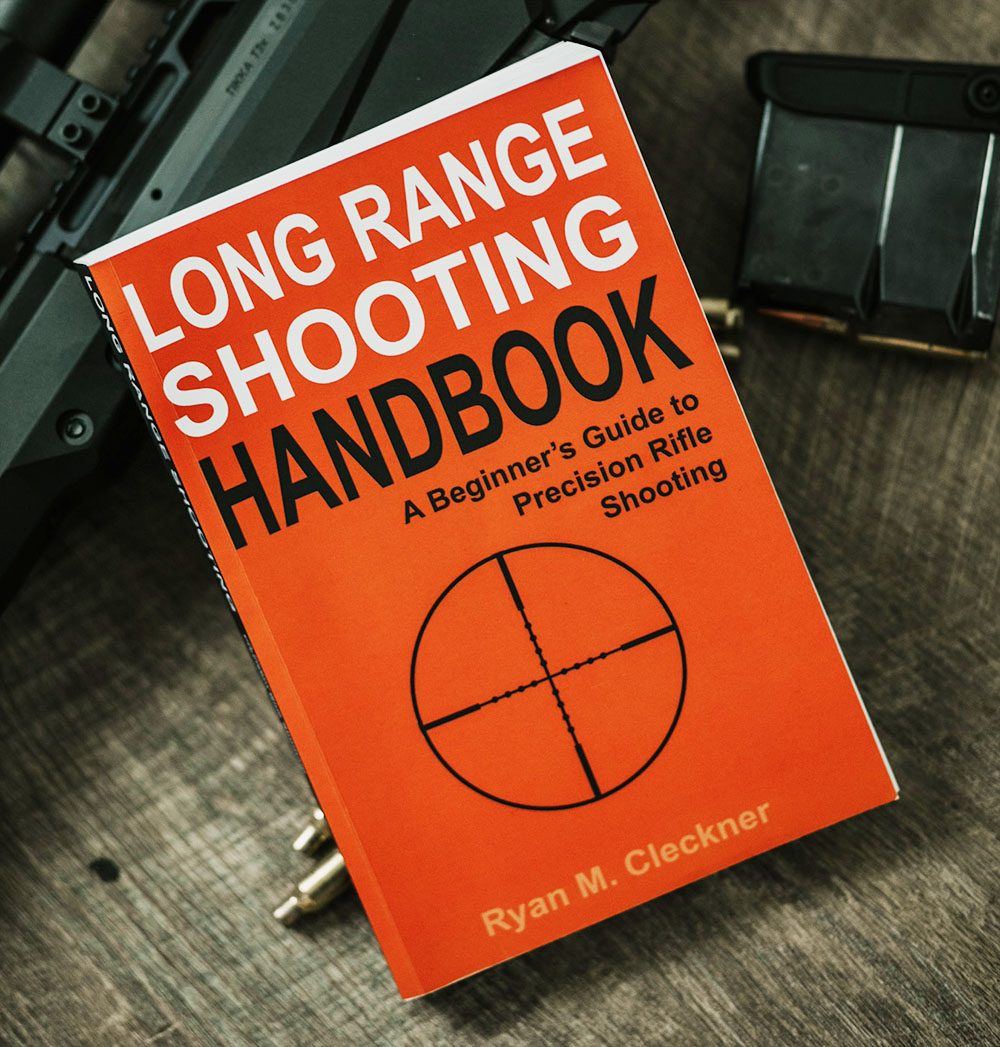
This book is the complete beginner’s guide to long range shooting written in simple every-day language so that it’s easy to follow.
Included are personal tips and best advice from Ryan’s years of special operations sniper schooling and experience, and as a sniper instructor.
What Are Milliradians? FAQ
Q: How big is 1 Mil at 100 meters?
A: A Mil is 10 centimeters large at 100 meters.
Q: What is 1 Mil at 100 Yards?
A: 1 Mil at 100 yards is 3.6 inches (or just over 9 cm)
Q: How big is 1/10th of a Mil (0.1 Mil) per 100 meters?
A: 1/10th of a Mil (0.1 Mil) is 1 centimeters per 100 meters.
Q: Are Mil and MOA the same thing?
A: No, Mil and MOA are not the same thing. However, they can be used in the same way as they are both angular measurements. “MOA” is short for Minute of Angle (1/60th of a degree).
Q: What does “Mil” stand for?
A” The term “Mil” is short for Milliradian (1/1000th of a Radian)
Q: What are Mils used for?
A: Mils are used for adjusting a rifle scope either to sight in a rifle (zero) or to engage targets at different distances.
Q: Which can be adjusted on a scope more precisely (finely), MOA or Mil?
A: MOA can be adjusted in finer (smaller/precise) increments than Mils for most scopes. This is because most scopes that adjust in MOA adjust in 1/4 MOA per “click” whereas most Mil scopes adjust in 1/10 Mil per “click.” At 100 yards, 1/4 MOA is 0.25″ whereas 1/10th Mil is 0.36″
Q: How many clicks are 1 Mil increments on my scope?
If you have a Mil scope, it most likely adjusts in 10 clicks for 1 Mil increment. It’s important that you as the shooter know how much of an adjustment on your turret will move your bullet impact.
Mil Table
In this Mil table, we’ve given you easy conversions between Mils and MOA along with their sizes in inches and centimeters at different distances.
If you’d like to convert these numbers on your own, please see the Milliradian Formulas above.
| Mils | MOA | CM per 100 meters | inches/100 yards (exact) |
|---|---|---|---|
| 0.1 | 0.34 | 1 | 0.36 |
| 0.2 | 0.69 | 2 | 0.72 |
| 0.3 | 1.03 | 3 | 1.08 |
| 0.4 | 1.38 | 4 | 1.44 |
| 0.5 | 1.72 | 5 | 1.80 |
| 0.6 | 2.06 | 6 | 2.16 |
| 0.7 | 2.41 | 7 | 2.52 |
| 0.8 | 2.75 | 8 | 2.88 |
| 0.9 | 3.09 | 9 | 3.24 |
| 1 | 3.44 | 10 | 3.60 |
| 1.1 | 3.78 | 11 | 3.96 |
| 1.2 | 4.13 | 12 | 4.32 |
| 1.3 | 4.47 | 13 | 4.68 |
| 1.4 | 4.81 | 14 | 5.04 |
| 1.5 | 5.16 | 15 | 5.40 |
| 1.6 | 5.50 | 16 | 5.76 |
| 1.7 | 5.84 | 17 | 6.12 |
| 1.8 | 6.19 | 18 | 6.48 |
| 1.9 | 6.53 | 19 | 6.84 |
| 2 | 6.88 | 20 | 7.20 |
| 2.1 | 7.22 | 21 | 7.56 |
| 2.2 | 7.56 | 22 | 7.92 |
| 2.3 | 7.91 | 23 | 8.28 |
| 2.4 | 8.25 | 24 | 8.64 |
| 2.5 | 8.60 | 25 | 9.00 |
| 2.6 | 8.94 | 26 | 9.36 |
| 2.7 | 9.28 | 27 | 9.72 |
| 2.8 | 9.63 | 28 | 10.08 |
| 2.9 | 9.97 | 29 | 10.44 |
| 3 | 10.31 | 30 | 10.80 |
| 3.1 | 10.66 | 31 | 11.16 |
| 3.2 | 11.00 | 32 | 11.52 |
| 3.3 | 11.35 | 33 | 11.88 |
| 3.4 | 11.69 | 34 | 12.24 |
| 3.5 | 12.03 | 35 | 12.60 |
| 3.6 | 12.38 | 36 | 12.96 |
| 3.7 | 12.72 | 37 | 13.32 |
| 3.8 | 13.06 | 38 | 13.68 |
| 3.9 | 13.41 | 39 | 14.04 |
| 4 | 13.75 | 40 | 14.40 |
| 4.1 | 14.10 | 41 | 14.76 |
| 4.2 | 14.44 | 42 | 15.12 |
| 4.3 | 14.78 | 43 | 15.48 |
| 4.4 | 15.13 | 44 | 15.84 |
| 4.5 | 15.47 | 45 | 16.20 |
| 4.6 | 15.81 | 46 | 16.56 |
| 4.7 | 16.16 | 47 | 16.92 |
| 4.8 | 16.50 | 48 | 17.28 |
| 4.9 | 16.85 | 49 | 17.64 |
| 5 | 17.19 | 50 | 18.00 |
| 5.1 | 17.53 | 51 | 18.36 |
| 5.2 | 17.88 | 52 | 18.72 |
| 5.3 | 18.22 | 53 | 19.08 |
| 5.4 | 18.57 | 54 | 19.44 |
| 5.5 | 18.91 | 55 | 19.80 |
| 5.6 | 19.25 | 56 | 20.16 |
| 5.7 | 19.60 | 57 | 20.52 |
| 5.8 | 19.94 | 58 | 20.88 |
| 5.9 | 20.28 | 59 | 21.24 |
| 6 | 20.63 | 60 | 21.60 |
| 6.1 | 20.97 | 61 | 21.96 |
| 6.2 | 21.32 | 62 | 22.32 |
| 6.3 | 21.66 | 63 | 22.68 |
| 6.4 | 22.00 | 64 | 23.04 |
| 6.5 | 22.35 | 65 | 23.40 |
| 6.6 | 22.69 | 66 | 23.76 |
| 6.7 | 23.03 | 67 | 24.12 |
| 6.8 | 23.38 | 68 | 24.48 |
| 6.9 | 23.72 | 69 | 24.84 |
| 7 | 24.07 | 70 | 25.20 |
| 7.1 | 24.41 | 71 | 25.56 |
| 7.2 | 24.75 | 72 | 25.92 |
| 7.3 | 25.10 | 73 | 26.28 |
| 7.4 | 25.44 | 74 | 26.64 |
| 7.5 | 25.79 | 75 | 27.00 |
| 7.6 | 26.13 | 76 | 27.36 |
| 7.7 | 26.47 | 77 | 27.72 |
| 7.8 | 26.82 | 78 | 28.08 |
| 7.9 | 27.16 | 79 | 28.44 |
| 8 | 27.50 | 80 | 28.80 |
| 8.1 | 27.85 | 81 | 29.16 |
| 8.2 | 28.19 | 82 | 29.52 |
| 8.3 | 28.54 | 83 | 29.88 |
| 8.4 | 28.88 | 84 | 30.24 |
| 8.5 | 29.22 | 85 | 30.60 |
| 8.6 | 29.57 | 86 | 30.96 |
| 8.7 | 29.91 | 87 | 31.32 |
| 8.8 | 30.25 | 88 | 31.68 |
| 8.9 | 30.60 | 89 | 32.04 |
| 9 | 30.94 | 90 | 32.40 |
| 9.1 | 31.29 | 91 | 32.76 |
| 9.2 | 31.63 | 92 | 33.12 |
| 9.3 | 31.97 | 93 | 33.48 |
| 9.4 | 32.32 | 94 | 33.84 |
| 9.5 | 32.66 | 95 | 34.20 |
| 9.6 | 33.00 | 96 | 34.56 |
| 9.7 | 33.35 | 97 | 34.92 |
| 9.8 | 33.69 | 98 | 35.28 |
| 9.9 | 34.04 | 99 | 35.64 |
| 10 | 34.38 | 100 | 36.00 |
| 10.1 | 34.72 | 101 | 36.36 |
| 10.2 | 35.07 | 102 | 36.72 |
| 10.3 | 35.41 | 103 | 37.08 |
| 10.4 | 35.76 | 104 | 37.44 |
| 10.5 | 36.10 | 105 | 37.80 |
| 10.6 | 36.44 | 106 | 38.16 |
| 10.7 | 36.79 | 107 | 38.52 |
| 10.8 | 37.13 | 108 | 38.88 |
| 10.9 | 37.47 | 109 | 39.24 |
| 11 | 37.82 | 110 | 39.60 |
| 11.1 | 38.16 | 111 | 39.96 |
| 11.2 | 38.51 | 112 | 40.32 |
| 11.3 | 38.85 | 113 | 40.68 |
| 11.4 | 39.19 | 114 | 41.04 |
| 11.5 | 39.54 | 115 | 41.40 |
| 11.6 | 39.88 | 116 | 41.76 |
| 11.7 | 40.22 | 117 | 42.12 |
| 11.8 | 40.57 | 118 | 42.48 |
| 11.9 | 40.91 | 119 | 42.84 |
| 12 | 41.26 | 120 | 43.20 |
| 12.1 | 41.60 | 121 | 43.55 |
| 12.2 | 41.94 | 122 | 43.91 |
| 12.3 | 42.29 | 123 | 44.27 |
| 12.4 | 42.63 | 124 | 44.63 |
| 12.5 | 42.97 | 125 | 44.99 |
| 12.6 | 43.32 | 126 | 45.35 |
| 12.7 | 43.66 | 127 | 45.71 |
| 12.8 | 44.01 | 128 | 46.07 |
| 12.9 | 44.35 | 129 | 46.43 |
| 13 | 44.69 | 130 | 46.79 |
| 13.1 | 45.04 | 131 | 47.15 |
| 13.2 | 45.38 | 132 | 47.51 |
| 13.3 | 45.73 | 133 | 47.87 |
| 13.4 | 46.07 | 134 | 48.23 |
| 13.5 | 46.41 | 135 | 48.59 |
| 13.6 | 46.76 | 136 | 48.95 |
| 13.7 | 47.10 | 137 | 49.31 |
| 13.8 | 47.44 | 138 | 49.67 |
| 13.9 | 47.79 | 139 | 50.03 |
| 14 | 48.13 | 140 | 50.39 |
| 14.1 | 48.48 | 141 | 50.75 |
| 14.2 | 48.82 | 142 | 51.11 |
| 14.3 | 49.16 | 143 | 51.47 |
| 14.4 | 49.51 | 144 | 51.83 |
| 14.5 | 49.85 | 145 | 52.19 |
| 14.6 | 50.19 | 146 | 52.55 |
| 14.7 | 50.54 | 147 | 52.91 |
| 14.8 | 50.88 | 148 | 53.27 |
| 14.9 | 51.23 | 149 | 53.63 |
| 15 | 51.57 | 150 | 53.99 |
| 15.1 | 51.91 | 151 | 54.35 |
| 15.2 | 52.26 | 152 | 54.71 |
| 15.3 | 52.60 | 153 | 55.07 |
| 15.4 | 52.95 | 154 | 55.43 |
| 15.5 | 53.29 | 155 | 55.79 |
| 15.6 | 53.63 | 156 | 56.15 |
| 15.7 | 53.98 | 157 | 56.51 |
| 15.8 | 54.32 | 158 | 56.87 |
| 15.9 | 54.66 | 159 | 57.23 |
| 16 | 55.01 | 160 | 57.59 |
| 16.1 | 55.35 | 161 | 57.95 |
| 16.2 | 55.70 | 162 | 58.31 |
| 16.3 | 56.04 | 163 | 58.67 |
| 16.4 | 56.38 | 164 | 59.03 |
| 16.5 | 56.73 | 165 | 59.39 |
| 16.6 | 57.07 | 166 | 59.75 |
| 16.7 | 57.41 | 167 | 60.11 |
| 16.8 | 57.76 | 168 | 60.47 |
| 16.9 | 58.10 | 169 | 60.83 |
| 17 | 58.45 | 170 | 61.19 |
| 17.1 | 58.79 | 171 | 61.55 |
| 17.2 | 59.13 | 172 | 61.91 |
| 17.3 | 59.48 | 173 | 62.27 |
| 17.4 | 59.82 | 174 | 62.63 |
| 17.5 | 60.16 | 175 | 62.99 |
| 17.6 | 60.51 | 176 | 63.35 |
| 17.7 | 60.85 | 177 | 63.71 |
| 17.8 | 61.20 | 178 | 64.07 |
| 17.9 | 61.54 | 179 | 64.43 |
| 18 | 61.88 | 180 | 64.79 |
| 18.1 | 62.23 | 181 | 65.15 |
| 18.2 | 62.57 | 182 | 65.51 |
| 18.3 | 62.92 | 183 | 65.87 |
| 18.4 | 63.26 | 184 | 66.23 |
| 18.5 | 63.60 | 185 | 66.59 |
| 18.6 | 63.95 | 186 | 66.95 |
| 18.7 | 64.29 | 187 | 67.31 |
| 18.8 | 64.63 | 188 | 67.67 |
| 18.9 | 64.98 | 189 | 68.03 |
| 19 | 65.32 | 190 | 68.39 |
| 19.1 | 65.67 | 191 | 68.75 |
| 19.2 | 66.01 | 192 | 69.11 |
| 19.3 | 66.35 | 193 | 69.47 |
| 19.4 | 66.70 | 194 | 69.83 |
| 19.5 | 67.04 | 195 | 70.19 |
| 19.6 | 67.38 | 196 | 70.55 |
| 19.7 | 67.73 | 197 | 70.91 |
| 19.8 | 68.07 | 198 | 71.27 |
| 19.9 | 68.42 | 199 | 71.63 |
| 20 | 68.76 | 200 | 71.99 |
Recent Posts
November 1, 2025
November 1, 2025
October 31, 2025
October 29, 2025

